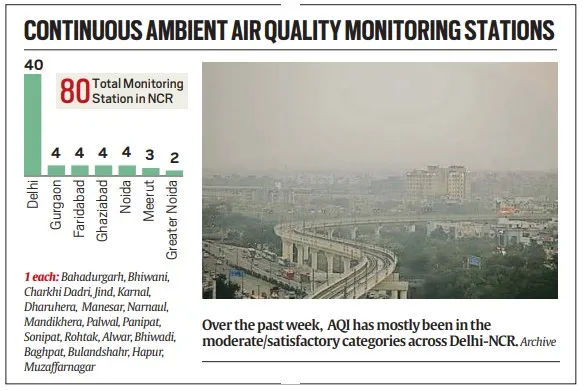As winter nears, experts flag gaps in system monitoring air pollution spike
Over the past week, the AQI has mostly been in the moderate/satisfactory categories across Delhi-NCR. The AQI in Delhi on Sunday was 134, in the “moderate” category.
 Over the past week, AQI has mostly been in the moderate/satisfactory categories across Delhi-NCR. (Express File Photo)
Over the past week, AQI has mostly been in the moderate/satisfactory categories across Delhi-NCR. (Express File Photo) With the winter – and the accompanying air pollution spike — around the corner, does the National Capital Region have enough devices to measure the extent of its pollution problem?
The Central Pollution Control Board’s (CPCB) list of Continuous Ambient Air Quality Monitoring Stations in Delhi-NCR shows a total of 80 stations in the National Capital Region. Of these, half, that is 40 stations, are in Delhi alone.
Of these 80 stations in the NCR, nine were found inactive on Sunday, going by the CPCB’s list. The inactive stations include five of the 40 stations in Delhi, one out of four stations each in Gurgaon and Noida, and the only stations that have been installed in Hapur and Baghpat. The districts of Bahadurgarh, Sonipat, Karnal, Panipat, Bhiwadi and Jind (in Haryana), and Bulandshahr and Muzaffarnagar (in UP) have only a single station each. Ghaziabad has four such stations while Greater Noida two.
Anumita Roychowdhury at the Centre for Science and Environment (CSE) said, “As far as Delhi is concerned, we don’t need to add more there. But the larger NCR has a lot of data shadow areas. It is only in the last few years that we have started seeing the expansion of the grid in the NCR. That requires some rationalisation. NCR requires more monitors representative of various land uses, such as industrial or residential areas.”
 Over the past week, AQI has mostly been in the moderate/satisfactory categories across Delhi-NCR. (Express File Photo)
Over the past week, AQI has mostly been in the moderate/satisfactory categories across Delhi-NCR. (Express File Photo)
Dipankar Saha, former head of CPCB’s air laboratory, said, “The zone of influence of a single analyzer is not known. If it is placed in an industrial area, or at a traffic junction, or a residential area, it reflects that. The aim is to improve the quality of air, and our regulatory aim should be to reduce the toxicity level of the pollutants. For that, measuring particulate matter is not sufficient.”
“Manual monitoring is necessary so that toxicity levels can be determined. In manual stations, particulate matter collected on filter paper is analysed to determine metallic and chemical composition…what it contains.”
As part of its policy to curb air pollution in the NCR, released last year, the Commission for Air Quality Management (CAQM) said that a plan needs to be developed for air quality monitoring network in the NCR “based on a revised criteria (based on land-use, population density, urban to regional scale, etc)”. It stated that for NCR districts, the CPCB and State Pollution Control Boards need to implement a plan for installation of identified new monitoring stations or those that are to be relocated. Fifty per cent of these identified new stations were to be set up by this December, and the remaining by end of next year.
Besides, the CAQM policy pointed to an “asymmetry” in distribution of monitors. “Of the 65 manual stations in the NCR, only 20 have PM2.5 monitors,” it added.
An official in a regional offices of the UPPCB in the NCR pointed out that restrictions under the Graded Response Action Plan (GRAP) kick in based on the AQI in Delhi, irrespective of the number of air quality monitoring stations in the other districts of the NCR.
AQI in moderate category
Over the past week, the AQI has mostly been in the moderate/satisfactory categories across Delhi-NCR. The AQI in Delhi on Sunday was 134, in the “moderate” category. It was in the ‘moderate’ category in Noida, Faridabad, Gurgaon and Ghaziabad as well on Sunday, while it was in the ‘poor’ category in Greater Noida, going by CPCB data.







